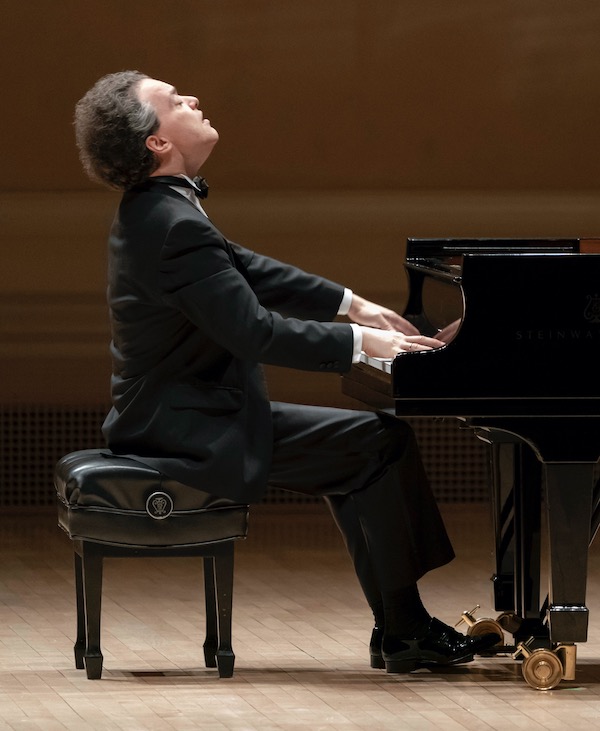Kissin’s artistry offers finely balanced meal, saving the fireworks for last at Carnegie
There was just one rule at pianist Evgeny Kissin’s recital Friday at Carnegie Hall: No dessert till you eat your vegetables.
But the vegetables—music by Bach, Mozart and Beethoven, plus a plate of Chopin’s quirky mazurkas–were served with such rich and savory sauces of pianistic color that one almost forgot about dessert.
Then the kitchen doors swung open and the flaming platter appeared, bearing Chopin’s sweet and fiery Andante spianato and Grande polonaise brilliante, Op. 22, and dessert was served: virtuoso pianism of the early 20th-century Russian school, surviving somehow in the playing of this pianist born in 1971.
In fact, the artist dedicated Friday’s program to the late Anna Pavlovna Kantor, his sole teacher since age six, who died last year at age 98. There were even some pedagogical echoes in the evening’s repertoire: Bach and Mozart were the composers whose music Chopin assigned to his pupils, before his own compositions joined that required regime in later generations.
And then there’s Beethoven, the composer every pianist must grapple with sooner or later. Over the years, Kissin has triumphed with the fierce focus of the “Appassionata” Sonata and struggled a bit to grasp the visionary last sonata in C Minor, Op. 111. On Friday, he found a more congenial warmth and flow in the latter’s litter-mate, the Sonata in A-flat major, Op. 110.
Following an old precedent, Kissin opened the program with Bach in a 19th-century arrangement, in this case the celebrity of Bach organ works, the Toccata and Fugue in D minor, BWV 565. The piano version by the legendary virtuoso Carl Tausig, finger-twisting though it was, stuck close to Bach’s original, needing few extra elaborations to convey the organ piece’s grandeur and fire. For his part, Kissin avoided Romantic phrasing in favor of a more organ-like presentation, with terraced dynamics, chugging rhythms and color changes that echoed organ registration. For all its Romantic pedigree, this performance sounded surprisingly faithful to its Baroque roots.
Mozart’s Adagio in B minor, K. 540, is a one-of-a-kind, searching late work, full of hesitations and silences, under which one sensed, in Friday’s performance, a steady pulse that buoyed the music along. It seemed to relate to the works around it on the program, beginning with a Chopinesque singing line over a rich bass, and eventually the stopped-time feeling of a Beethoven Adagio.
Then it was time for Beethoven himself in a leisurely mood, with the tender opening song of Op. 110 blossoming into a ripple of arpeggios that favored a Romantic wash of sound over Classical lucidity. Again, Kissin’s steady tempo enabled the shapely phrases to relate to and build on each other. The pianist approached the contrasting minor-key Allegro molto with a light touch, not overly aggressive, the syncopated accents more full-bodied than harsh.
This reflective performance darkened considerably in the doleful descending phrases of the Adagio, ma non troppo, with sensitively voiced left-hand chords marking the slow tempo under the operatic aria d’affetto. A kinder, gentler version of the inexorable momentum of Bach’s D minor organ fugue propelled the sonata’s fugal finale, with its sturdy walking subject, which Kissin artfully highlighted amid the contrapuntal complications. After a pause to reflect even more darkly on the Adagio theme, a remarkable return-to-life crescendo of repeated chords ushered in the fugue’s scintillating conclusion, backed by all the rich, weighty forte this Russian-trained pianist could muster.
Seven Chopin mazurkas followed intermission, each one a little (or not so little) folk-dance poem, programmed (as it happened) in exact order of publication: the B-flat major, Op. 7, no. 1, bright and extroverted with its comical dissonant appoggiatura; the G minor, Op. 24/1, a sad modal song that cheered up in the middle; a strutting C major, Op. 24/2, with sparkling syncopations; a velvet-toned C minor, Op. 30/1; the B minor, Op. 30/2, contrasting chromatic and diatonic tunes, with different piano touch for each; a leisurely, thoughtful version of the C major, Op. 33/3; and Op. 33/4, a mazurka-epic in many sections, from veiled to sonorous.
In the long last piece and throughout the set, the pianist kept the dance beat going, while digging deep in his capacious bag of tone colors and touches to prevent mazurka monotony from setting in.
In 1830, when youth and comparatively good health still allowed the 20-year-old Chopin to aspire to a career as a touring virtuoso, he displayed his wares in a Grande polonaise brillante for piano and orchestra, later fitting this compendium of wows with a dreamy, spianato (literally, smoothed-out) prelude.
The work’s orchestral bits are easily folded into the piano part to make a piece for piano solo, which is how it is typically heard today. One does not, however, typically hear an andante as pearly and ethereal as Kissin’s on Friday, or a polonaise dispatched with such insouciant splendor. The audience eagerly devoured the long-delayed dessert.
The encores reprised the evening’s program: Bach, in Ferruccio Busoni’s tenebrous arrangement of the organ prelude “Nun komm der Heiden Heiland,” BWV 659; Mozart, in a dizzying performance of the lengthy Rondo in D major, K. 485, with all the score’s indicated repeats; and a show-offy rendering of Chopin’s “Heroic” Polonaise in A-flat major, Op. 53, more “Grande” than grand. A tender, glowing Chopin Waltz in F minor, Op. 70, No. 2, was the encore to the encores.
Carnegie Hall presents “Anne-Sophie Mutter and Friends,” including violinists Mutter and Ye-Eun Choi, violist Vladimir Babeshko and cellist Pablo Ferrández, performing string quartets by Haydn, Beethoven and Jörg Widmann, 8 p.m. Thursday, June 2. carnegiehall.org.
